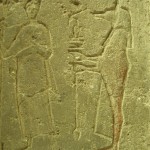 My name is Mariana Gomes Beirão, I’m Portuguese, 21, and I am currently doing a 3 month Erasmus internship in the Ure Museum as part of my MA in Ancient History, which I will defend next year. I have a degree in Languages, literatures and cultures with a major in English and minor in Italian. While doing my degree I discovered my fascination for classics mainly due to one of my Professors’ passion for his job. Rodrigo Furtado greatly influenced and impressed me to the point of, inadvertedly, entirely changing my course of studies. I began taking optional lectures and saw that they interested me more than my mandatory ones. I knew then I had to alter my path.
My name is Mariana Gomes Beirão, I’m Portuguese, 21, and I am currently doing a 3 month Erasmus internship in the Ure Museum as part of my MA in Ancient History, which I will defend next year. I have a degree in Languages, literatures and cultures with a major in English and minor in Italian. While doing my degree I discovered my fascination for classics mainly due to one of my Professors’ passion for his job. Rodrigo Furtado greatly influenced and impressed me to the point of, inadvertedly, entirely changing my course of studies. I began taking optional lectures and saw that they interested me more than my mandatory ones. I knew then I had to alter my path.
Moreover, before starting university I applied for an integrated masters’ in the Portuguese Army and was accepted. In my first year I sustained and injury to my knee and was forced to abandon my military career. At first I was devastated yet now it seems clear that the Moirae did their thing and everything fell into place. I find interest in learning about people long dead instead of being the one doing the killing.
Furthermore, my former summer jobs include working as a security guard in a golf resort, as a client liaison for a holiday rental company and for the past 3 years I’ve been teaching Portuguese as a foreign language to British ex-pats living in Portugal (to get a bit extra for the tuition). Finally, the least interesting aspects (not that any of the previous ones were particularly fascinating):
Firstly, I am a very active person, proof of that is that my fiancée owns the gym I go to (which is where we met). I enjoy running, doing gymnastics and kickboxing. Secondly, I love animals, especially horses, once again the fates had it all sorted as my soon to be husband has a few specimen of my favourite animal. Thirdly, I possess a PS3 and I proudly call myself a gamer. Lastly, I have failed to become a vegetarian due to the fact that Portugal isn’t very keen on rabbit food as almost everything has at least a pig’s internal organ in it.





